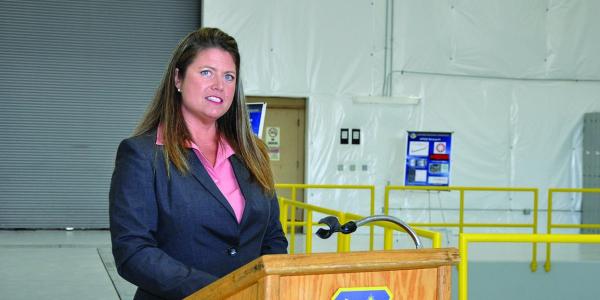Scientists Cook Up a Better Microwave Weapon
As cyber attacks and electronic warfare become ever-growing concerns in the battlespace, the need for electromagnetic technologies such as high-power microwave weapons becomes crucial to defend against threats.
Scientists at the Air Force Research Laboratory’s (AFRL’s) High-Power Microwave Division at Kirtland Air Force Base, New Mexico, are working to improve the electromagnetic technology used in the lab’s nonkinetic missile program called CHAMP, or the Counter-electronics High-powered Microwave Advanced Missile Project (SIGNAL Magazine, February 2016, “CHAMP Prepares For Future Flights”). The division first successfully deployed the technology with Boeing in a 2012 test flight over the Utah Test and Training Range.
In the demonstration, AFRL scientists put the high-power microwave (HPM) system onto a conventional air-launched cruise missile and flew it over the Utah desert. The prototype weapon worked as expected, knocking out the electronic target’s data and the electronic subsystems, recalls Mary Lou Robinson, chief of the AFRL’s High Power Electromagnetics Division within the lab’s Directed Energy Directorate.
“The cool thing about high-powered microwave technology is that it is a very controlled beam,” Robinson says. “The energy deposited can cause various effects, from disruption to damage of electronics targets without harming people at all—extremely low collateral damage.”
The AFRL’s research on HPMs is focusing on the ability to get more energy onto targets, she shares. “It’s all based on probabilities, and the probability of affecting a target increases with the amount of microwave energy you put on that target,” Robinson says.
However, much of the challenge of increasing microwave energy is related to so-called “breakdowns.” She explains that with HPMs, researchers are creating a signal that “is very much like an incredibly focused lightning strike. And if too much energy is put into the air, not all of the energy can pass through that medium, so the microwaves break down, and the signal doesn’t propagate.”
To get more energy onto targets while avoiding the risks of adding too much power or arcing, the scientists are using multiple pulses of microwaves. “Two pulses on the same target doubles the amount of energy on a target and increases the probability of impacting that target,” Robinson relays. “Those are the things we are working on now.”
To be able to have multiple pulses on the same platform, the systems need powerful batteries and very fast switches, capacitors that hold more energy, and a bigger antenna. All these components must fit within size, weight and volume restrictions for the Air Force’s airborne applications, Robinson says.
Naturally, larger aircraft can accommodate such a system, so researchers are looking at how it could fit into smaller aircraft. “Getting the same amount of power into a smaller package is really the hard part of it,” Robinson admits. “It is also not a simple challenge to design the necessary antennas.”
For the controls, the AFRL will rely on augmenting existing Air Force timing systems. “When you have an airborne platform, we have to be exact, and the Air Force in general has great capabilities in regard to timing systems,” Robinson says. “We have shown how accurate we can be with kinetic weapons, so we will use those same types of control technologies to ensure our accuracy with high-powered microwaves as well.”
Overall, the AFRL’s planned costs for its High-Powered Electromagnetics Research Program are about $28 million per year from fiscal years 2016 to 2020. The program—which includes CHAMP—is transitioning high-power electromagnetic systems and components onto airborne platforms for end users. The laboratory also is identifying and developing high-power electromagnetic technologies for cyber warfare applications and examining the technology’s effects at the device, circuit and system levels.
This research includes the study and formulation of cyber warfare scenarios and the demonstration of innovative defense concepts. The laboratory has several contractors supporting these efforts. Booz Allen Hamilton confirmed that it is researching the use of high-power electromagnetics in cyber warfare. Leidos is providing computer software modeling and simulation tools, which will model an end-to-end directed energy system, design studies and platform integration. Further details remain classified.




Comments